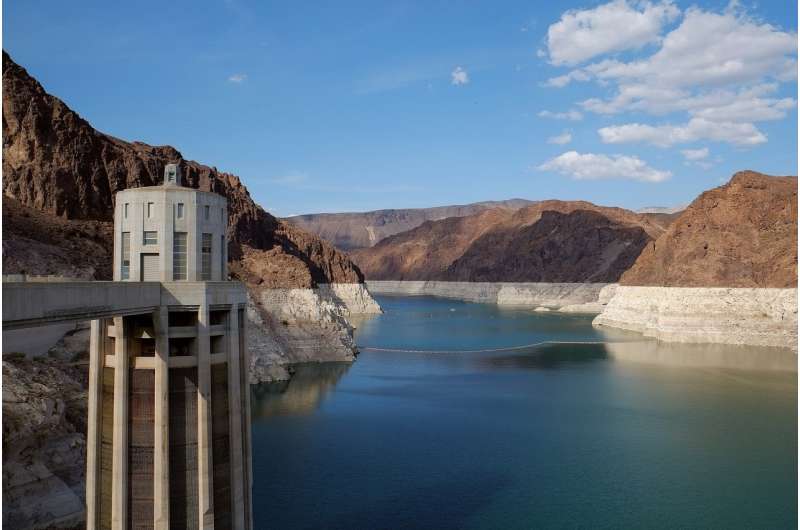This article has been reviewed according to Science X's editorial process and policies. Editors have highlighted the following attributes while ensuring the content's credibility:
fact-checked
peer-reviewed publication
trusted source
proofread
Droughts in Western states drive up emissions and threaten human health

When drought-stricken rivers and reservoirs run low across the American West, hydropower dries up and utilities fire up hundreds of power plants that burn coal, oil, or natural gas to keep up with demand for electricity. The timing couldn't be worse, as accompanying heat waves drive up energy use, often to power air conditioners.
A new Stanford University study finds these overlooked consequences of drought dramatically increase carbon emissions, methane leakage, and local air pollution and deaths caused by poor air quality.
Together, the social and economic cost of these impacts have cost 11 Western states tens of billions of dollars over the past two decades, according to the study, which was published July 6 in Proceedings of the National Academy of Sciences. In California alone, the increase in fossil generation caused by drought between 2012 and 2016 led to more than $5 billion in damages, two-and-a-half times the direct economic cost of switching from cheap hydropower to pricey fossil fuels.
Because climate change is making droughts in the American West more frequent and severe, the results indicate failure to account for these effects leads governments to underestimate the social and economic costs of global warming—and the worth of investments to combat it.
"Our research suggests the impact on greenhouse gas emissions, air pollution, and human health could represent a large and unaccounted-for cost of climate change," said lead study author Minghao Qiu, a postdoctoral scholar in the Stanford Doerr School of Sustainability and Stanford Center for Innovation in Global Health.
Not a local story
Qiu and co-authors estimate the total health and economic damages from drought-induced fossil electricity generation between 2001 and 2021 in U.S. Western states amounted to $20 billion, with the cost of carbon emissions accounting for the lion's share of that damage at $14 billion. Deaths associated with additional air pollution account for $5.1 billion and methane leakage accounts for just under $1 billion of the damage.
Like many climate impacts, these damages often bleed across borders. When hydropower runs low in Northwestern states that normally export electricity to regional neighbors, for example, communities in California and the Southwest feel the effects as fossil fuel power plants fire up to fill the gap.
"This is not a local story. A climate shock in one place can have serious ramifications for a totally different geographic area due to the interconnected nature of many energy systems," said Qiu, who works with senior study author Marshall Burke as part of the Environmental Change and Human Outcomes Lab at Stanford.
While the study focused on the American West, the researchers stress that many countries relying on hydropower around the world are facing greater drought risk due to climate change. In places where high-emitting coal-fired power plants are the most likely replacement for lost hydropower, the authors write that the economic and health damages from deteriorated air quality and greenhouse gas emissions will be higher than in U.S. Western states, which more often turn to natural gas.
"Our findings have implications for many other parts of the world that depend on hydropower but could face increasing drought," said Burke, an associate professor in the global environmental policy area of the Stanford Doerr School of Sustainability's social sciences division. "In these regions, drought's interaction with the energy system can have a cascading series of negative impacts on emissions and health."
More renewable energy needed
The authors calculated damages based on widely accepted estimates for the costs of carbon and methane emissions, and the statistical value of a human life in the way that regulators calculate it, as well as the best available estimate for how much methane leaks to the atmosphere during the production, processing, and transportation of oil and gas (2.3% per unit of gas consumed).
In states that rely heavily on hydropower for electricity generation, such as Washington, California, and Oregon, planet-warming emissions caused by drought-induced shifts in the energy supply could account for up to 40% of all greenhouse gas emissions from electricity in future drought years, the research shows, even as more solar, wind, and battery storage come online. The research suggests that increasingly frequent droughts will make it more challenging for the electricity sector to fully decarbonize and hydro-reliant states will need to pursue extra initiatives to achieve net-zero emission goals.
That's because when electricity demand spikes, utilities generally turn to fossil fuels to temporarily boost supply. In the coming decades, even as renewable energy and energy storage cover more of the overall average demand for electricity in the American West, fossil fuel based power plants are projected to remain the dominant energy source for these marginal energy needs.
"If we want to solve this issue, we need an even greater expansion of renewable energy alongside better energy storage, so we don't need to tap into fossil fuels as much," said Qiu. "Ultimately, to limit future warming and the drought risks that come with it, we need to reduce our emissions."
More information: Minghao Qiu et al, Drought impacts on the electricity system, emissions, and air quality in the western United States, Proceedings of the National Academy of Sciences (2023). DOI: 10.1073/pnas.2300395120
Journal information: Proceedings of the National Academy of Sciences
Provided by Stanford University





















